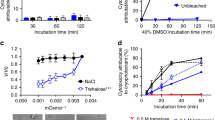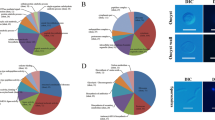Abstract
Heating or freezing leads to loss in infectivity of oocysts of Cryptosporidium parvum toward neonatal BALB/c mice and is reflected in the profile of the polar lipid fatty acids. Upon loss of infectivity, the ratio of polar lipid to neutral lipid fatty acid decreased and the relative proportions of 18∶1n-9 also decreased; proportions of 18∶2n-6 and 20∶5n-6 increased, whereas the proportions of 16∶0 remained constant with freezing. During these investigations, a novel fatty acid, 10-OH 18∶0, was discovered in the glycolipid fraction. The identification of a fatty acid unique to species of Cryptosporidium was thought to provide a specific biomarker for this organism. Cryptosporidium also demonstrated fluctuations in absolute quantities of 10-OH 18∶0 with events that lead to loss of infectivity. This led to the presumed correlation of this biomarker with infectious Cryptosporidium. The 10-OH 18∶0 was putatively localized at the sn-2 position of phosphatidylethanolamine. High-performance liquid chromatography/electrospray ionization mass spectrometry revealed that the 10-OH 18∶0 existed principally in the free fatty acid form. Herein, we establish that the free fatty acid 10-OH 18∶0 was, in actuality, an artifact of the procedures for sample preparation.
Similar content being viewed by others
Abbreviations
- CID:
-
collision-induced dissociation
- FAB:
-
fast ion bombardment
- GC:
-
gas chromatography
- HPLC/ESI/MS:
-
high-performance liquid chromatography/electrospray ionization/mass spectrometry
- PE:
-
phosphatidylethanolamine
- 10-OH 18∶0:
-
10-hydroxy stearic acid
References
Fayer, R. (ed.) (1997) Cryptosporidium and Cryptosporidiosis, CRC Press, Boca Raton.
Newman, A. (1995) Analyzing for Cryptosporidium. Anal. Chem. 67, 731A-734A
Fayer, R., and Nerad, T.R. (1996) Effects of Low Temperature on Viability of Cryptosporidium parvum Oocysts. Appl. Environ. Microbiol. 62, 1431–1433.
White, D.C., Alugupalli, S., Schrum, D.P., Kelly, S.T., Sikka, M.K., Fayer, R., and Kaneshiro, E.S. (1997) Sensitive Quantitative Detection/Identification of Infectious Cryptosporidium parvum by Signature Lipid Biomarker Analysis. 1997 Intermational Symposium on Waterborne Cryptosporidium Proceedings (Fricker, C.R., Chancy, J.L., and Rochelle, P.A., eds.) pp. 53–59. American Water Works Association, Denver.
Schrum, D.P., Alugupalli, S., Kelly, S.T., White, D.C., and Fayer, R. (1997) Structural Characterization of a “Signature” Phosphatidylethanolamine as the Major 10-Hydroxy Stearic Acid Containing Lipid of Cryptosporidium parvum Oocysts, Lipids 32, 789–793.
Burkhalter, R.S., Smith, C.A., Peacock, A., White, D.C., Whitaker, K.W., and Fayer, R. (1998). Delection of Single Infectious Cryptosporidium Oocyst by Signature Free Fatty Acid 10-OH 18∶0, Abstracts, Annual meeting of the American Society for Microbiology, Atlanta, May 1998.
White, D.C., Davis, W.M., Nickels, J.S., King, J.D., and Bobbie, R.J. (1979) Determination of the Sedimentary Microbial Biomass by Extractable Lipid Phosphate, Oecologia 40, 51–62.
Bligh, E.G., and Dyer, W.J. (1959) A Rapid Method of Total Lipid Extraction and Purification. Can. J. Biochem. Physiol 37(8), 911–917.
Guckert, J.B., Antworth, P.D., Nichols, P.D., and White, D.C. (1985). Phospholipid, Ester-Linked Fatty Acid Profiles as Reproducible Assays for Changes in Prokaryotic Community Structures of Estuarine Sediments, FEMS Microbial. Ecol. 31, 147–158.
Burkhalter, R.S., Tuinman, A.A., Smith, C.A., Whitaker, K.W., White, A.B., and White, D.C. (1998) Detection of Signature Lipid Biomarkers Specific to Infections Cryptosporidium. Abstracts. American Society for Mass Spectrometry, Orlando, June 1998.
Tomer, K.B., Jensen, N.J., and Gross, M.L. (1986) Fast Atom Bombardment and Tandem Mass Spectrometry for Determining Structural Modification of Fatty Acids, Anal. Chem. 58, 2429–2433.
White, D.C. (1995) Chemical Ecology: Possible Linkage Between Macro- and Microbial Ecology, Oikos 74, 174–181.
Author information
Authors and Affiliations
About this article
Cite this article
Burkhalter, R.S., Smith, C.A., White, D.C. et al. The signature 10-hydroxy stearic acid thought to correlate with infectivity in oocysts of Cryptosporidium species is an artifact. Lipids 33, 829–833 (1998). https://doi.org/10.1007/s11745-998-0278-7
Received:
Revised:
Accepted:
Issue Date:
DOI: https://doi.org/10.1007/s11745-998-0278-7




